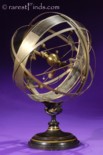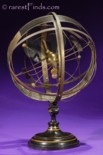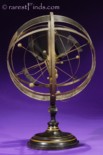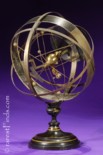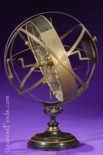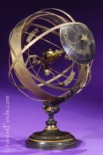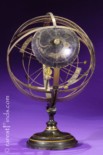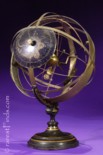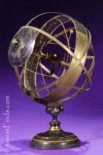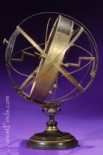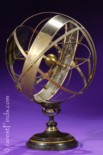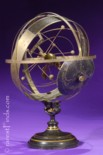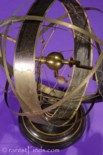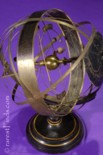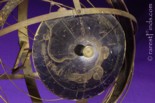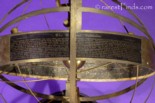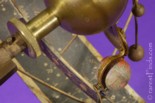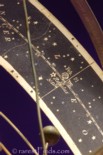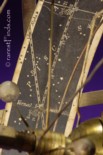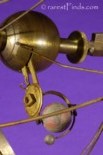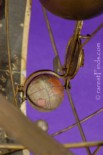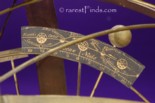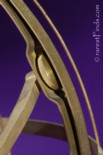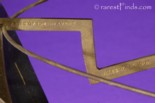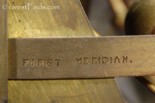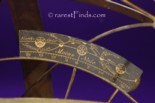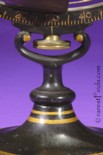Rare Bryant's Celestial Indicator, pat. Sept. 10, 1872., Price $8,750
Patents, click on any image to see larger image!



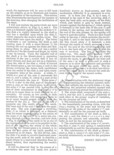
Henry Bryant of Hartford, Connecticut, invented this beautiful armillary spheres with an orrery for which he was awarded the patent with the number 131,148 on September 10, 1872, see patent images above.
This remarkable American astronomical device measures 18 inches in height, 11½ inches in diameter, and has a black lacquered cast iron base with original gilt pin-striping and a diameter of 7½ inches.
A series of calibrated brass Compernican Armillary bands form a spherical frame which surrounds an internal orrery mechanism comprised of the seven known planets at the time, Mercury, Venus, Mars, Jupiter, Saturn, Uranus, and Neptune. These seven planets mounted on adjustable wire armatures have different sizes, and also different distances to the spherical brass sun in the very center of the Spheres.
The revolving moon sphere circling the paper-covered earth which demonstrates its movement over the span of one year and the changes in season due to the earth’s constant axial tilt or obliquity of the ecliptic of about 23.5º relative to the Sun’s axis.
The brass armillary sphere is showing the planetary orbits with a paper zodiac band of constellations of the stars on the inner band, and a label with “EXPLANATIONS AND DIRECTIONS” on the outer band, see picture 16.
Two rectangular plates showing the sun”s motion along the ecliptic path according to equatorial coordinates, i.e. right ascension and declination and the celestial equator, see picture 22 and 26. I found a wonderful website explaining the phenomena in [3].
There are two turning knobs on the outer part of the sphere on each end of the axis of the heavens and the sun to turn the planets of the solar system. Near the spherical sun is another knurled brass knob to activate the orrery mechanism inside the sun to turn the sun and at the same time keep the axis of the earth constant, hence demonstrate the change of the seasons, see picture 17 and 20.
On a rounded plate is a paper label showing the northern sky including the serpent constellation, see picture 15. The round cast iron base has a mechanism which allows to adjust the axis from 0º to 47º, see picture 27.
One of the most interesting and sophisticated American globe/planetary devices ever invented, and, rare!
Bryant’s patented Celestial Indicator is a unique two-in-one apparatus, combining an armillary sphere and an inner orrery that shows relative planetary movement in the solar system. The subjects of celestial measurements, meaning of right ascension and declination, precession of the equinoxes, the ecliptic and celestial equator, solar and lunar eclipses, spring and neap tide, and much more can be explained using the Bryant Celestial Indicator. The instrument was sold at the time for $25.00.
In his patent application, Bryant stated that the device was intended for astronomical instruction in schools and colleges; he also provided a lengthy description of its functions with “Testimonials” in a 32 page booklet, titled, “A Synopsis of the Elements of Astronomy, and a Description of the Celestial Indicator.“
[2]. A copy was included with the purchase of the Indicator and was also available for 10 Cents. Bryant referred to his booklet also on the label "EXPLANATIONS AND DIRECTIONS" at the end of the text. The label is applied to the outside ot the wide armillary sphere as shown in picture 16 and reads as follows:
By HENRY BRYANT The Celestial Indicator HARTFORD CONN.
EXPLANATIONS AND DIRECTIONS.— The outside frame represents the Sphere of the Heavens, the revolving meridian is to find right ascension, and the declination. The center ball represents the Sun. The balls on the revolving arms are for the Earth and the Moon. The other small balls represent the planets. The shaft indicates the Axis of the Heavens, Axis of the Sun, and the Axis of the Ecliptic. The rim of the wire inside, and around the Equator of the Heavens, is also to represent it. This ring, and the one crossing it at right angles, representing the first meridian, represent a movable Sphere, being attached to the revolving Axis of the Heavens. To revolve the Earth, make fast the two spares, by turning the thumb-nut on the outside; or hold fast the shaft by the thumb-piece with the left hand; then revolved the thumb-slide to the left, and the Earth will move around the Sun, keeping its Poles parallel to the axis of the Heavens, thus showing the changes of the Seasons.
The Earth’s nutation is represented by the backward movement of the right arm that supports the North Pole of the Earth. The small rim of wire is for the Moon”s path around the Sun; her nodes are where the rim intersects the Plane of the Ecliptic. The nodes revolve to the right, or westward; the amount of their semi-annular motions is marked on the disc. Place the Planets in their respective Signs, to show their conjunctions and retrograde motion. To indicate the position of the different Polar stars, and to show the precession of the Equinoxes, revolve the Axis of the Heavens, westward, around the Pole of the Ecliptic, and the equinoctial points will be seen to recede on the Ecliptic. At the same time, the Equator of the Heavens, represented by the rim of wire, will move among the stars, thus showing the change in their declinations, as well as in their right ascension. The amount of the motion of these points of the Heavens is about 1º in 71 years. The Nebulous theory is explained by the positions and motions of the Celestial bodies on the Zodiac.
[See synopsis of the. Elements of Astronomy accompanying the Celestial Indicator.] (Patented Sept. 10, 1872.)
Bryant’s Celestial Indicators can be found in major museums, such as the National Museum of American History, Smithsonian Institute; Connecticut Historical Society, Hartford, Connecticut; Whipple Museum of the History of Science, Cambridge, United Kingdom, and others.
Condition:
This Indicator is in excellent condition overall. Some tarnishing of metals consistent with age. The mechanism to demonstrate the earth's movement around the sun works perfect.
This Indicator is basically in the condition it was found; no cleaning other than dusting has been performed. There is very minimal loss of the fragile paper labels as shown in the pictures. The instruction label is perfect, see picture 16.
History:
An armillary sphere (variations are known as spherical astrolabe, armilla, or armil) is a model of objects in the sky (on the celestial sphere), consisting of a spherical framework of rings, centered on Earth or the Sun, that represent lines of celestial longitude and latitude and other astronomically important features, such as the ecliptic. As such, it differs from a celestial globe, which is a smooth sphere whose principal purpose is to map the constellations. It was invented separately first in ancient China during the 4th century BC and ancient Greece during the 3rd century BC, with later uses in the Islamic world and Medieval Europe.
With the Earth as center, an armillary sphere is known as Ptolemaic, or geocentric model. With the Sun as center, it is known as Copernican, or heliocentric model.
An orrery is a mechanical model of the Solar System that illustrates or predicts the relative positions and motions of the planets and moons, usually according to the heliocentric model. It may also represent the relative sizes and distances of these spheres; however, since accurate scaling is often not practical due to the actual large ratio differences, a subdued approximation may be used instead.
Though the Greeks had working planetaria, the first orrery that was a planetarium of the modern era was produced in 1704, and one was presented to Charles Boyle, 4th Earl of Orrery — hence the name. They are typically driven by a clockwork mechanism with a sphere representing the Sun at the center, and with a planet at the end of each of the arms.
Literature:
(Click on any title to see the online version of the book or publication if there is one.)
[1]
Warner, D. J. Rittenhouse, Vol. 2, No. 1, p. 31; Bryant, Henry A Synopsis of the Elements of Astronomy, and a Description of the Celestial Indicator Hartford
[2]
Bryant, Henry. A Synopsis of the Elements of Astronomy, and a Description of the Celestial Indicator Hartford: 1872.
[3]
The Ecliptic: the Sun”s Annual Path on the Celestial Sphere, Durham University, Dep. of Physics, User”s Guide to the Night Sky.
[4]
Illustrated Catalogue of School Merchandise. Boston: J.L. Hammett, 1872, p. 74.
Inventory Number 08755;
Price: $ 8,750.00.
Prices realized in the past:
- Bonhams Skinner, April 25-26, 2015, $13,000 plus 25% buyer's premium for a total of $16,250 (not including 6.25% sales tax.)
- Bonhams Skinner, November 30, 2022, $10,838 including buyer's premium.
